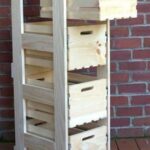Woodwork on a ceiling can add a touch of elegance and sophistication to any space. However, over time, it is not uncommon for wooden ceilings to develop issues such as cracks, rot, or warping. Not only do these problems compromise the aesthetic appeal of the woodwork, but they can also pose structural risks if left unaddressed. Therefore, knowing how to fix woodwork on a ceiling is essential for maintaining the beauty and integrity of your home or workspace.
In this article, we will guide you through the process of repairing woodwork on a ceiling step by step. From identifying common issues to gathering the tools and materials needed for the job, we’ll cover all aspects of restoring your wooden ceiling to its former glory. We’ll also provide you with tips on preparing and protecting the area before starting the repair, along with techniques for removing or repairing damaged wood.
Once the woodwork has been repaired, we’ll walk you through the steps of patching and filling any gaps or imperfections that may be present. We’ll also discuss how to achieve a seamless finish by sanding and smoothing the repaired areas. Lastly, we’ll explore options for staining or painting your woodwork to enhance its appearance and protect it from future damage.
By following our guidelines and implementing preventive maintenance measures, you can prolong the life of your woodwork and ensure that it continues to contribute to the overall beauty and value of your space. So let’s dive in and learn how to fix woodwork on a ceiling – you’ll be amazed at what a difference it can make.
Common Issues
Identifying the Problems with Woodwork on a Ceiling
When it comes to maintaining woodwork on a ceiling, it is essential to be able to identify common issues that may arise. Understanding these problems will help you diagnose the issue at hand and determine the appropriate solution. In this section, we will discuss some of the most common issues that can occur with woodwork on a ceiling.
Cracks
One of the most noticeable problems with woodwork on a ceiling is cracks. Cracks can occur due to various reasons such as natural expansion and contraction of the wood, improper installation, or age-related deterioration. It’s crucial to identify whether the crack is superficial or if it extends deeper into the wood structure. Superficial cracks can often be easily repaired, while deeper cracks may require more extensive repairs and professional attention.
Rot
Another significant issue with woodwork on a ceiling is rot. Rot typically occurs when moisture infiltrates the wood, causing fungal growth and decay. Signs of rot include discolored and soft areas on the wood surface, as well as a musty odor. If left untreated, rot can compromise the structural integrity of the woodwork and potentially spread to other areas. Identifying rot early on is crucial in preventing further damage and ensuring successful repairs.
Warping
Warping is another problem that commonly affects woodwork on ceilings. Warping occurs when moisture imbalance causes uneven shrinking or expansion of the wood, resulting in a curved or twisted appearance. Signs of warping may include uneven gaps between boards or visible distortions in shape. Identifying warped sections is crucial as it indicates underlying moisture issues that need to be addressed before any repair work begins.
By being able to identify these common issues with woodwork on a ceiling – cracks, rot, and warping – homeowners can take timely action for repair and restoration work. Identifying the problem accurately is the first step towards achieving a successful repair outcome. In the next sections, we will discuss the tools and materials necessary for woodwork repair, as well as the steps required to safeguard the area before starting the repairs.
Tools and Materials
When it comes to repairing woodwork on a ceiling, having the right tools and materials is essential for a successful project. Before getting started, make sure you have gathered all the necessary items to ensure a smooth and efficient repair process.
Tools
One of the most important tools you’ll need is a ladder or scaffolding to safely reach the ceiling. Make sure it is sturdy and secure before climbing up. Other essential tools include:
- Tape measure: To accurately measure the dimensions of damaged areas or sections that need repair.
- Pry bar: Used to carefully remove any trim or molding surrounding the damaged woodwork.
- Hammer and nails: For securing loose or sagging woodwork after repairs are complete.
- Screwdriver or drill: Needed to remove screws or fasteners holding the woodwork in place.
- Putty knife: Used for applying filler during patching and filling processes.
- Chisel: Helpful for removing any rotted or damaged sections of woodwork.
- Saw: Depending on the extent of damage, you may need a hand saw or power saw to cut out and replace sections of woodwork.
- 1.Wood filler: Used to fill cracks and gaps in damaged woodwork.
- 2.Epoxy resin: A strong adhesive used for bonding detached pieces of wood together.
- 3.Sanding paper or sandpaper block: Necessary for smoothing and blending the repaired areas with the existing woodwork.
- 4.Plaster or joint compound (for plaster ceilings): Required for repairing holes, cracks, or damage in plaster ceilings where applicable.
- 5.Primer and paint/stain: These materials are needed if you plan on painting or staining your restored woodwork for a polished finish.
- 6.Safety equipment: It’s important to prioritize safety during any repair project. So, make sure you have safety goggles, gloves, and a dust mask to protect yourself from potential hazards.
Materials
Having the right materials is just as important as having the right tools. Here are some essential materials you’ll need for woodwork repair on your ceiling:
By having all the necessary tools and materials ready before starting your woodwork repair project, you can save time and ensure that you have everything on hand whenever you need it. With these essential items in place, you are now ready to move on to the next steps of preparing and protecting the area before beginning the repair process.
Preparing and Protecting
Before you start repairing the woodwork on your ceiling, it is important to take the necessary steps to prepare and protect the area. By doing so, you will not only ensure a smooth and successful repair process, but also prevent any further damage or mess during the project.
The first step in preparing and protecting the area is to clear out any furniture or objects that may obstruct your work or get in the way. This will give you plenty of space to move around and access the damaged woodwork easily. Covering these items with drop cloths or plastic sheets can provide an extra layer of protection from dust, debris, and accidental spills.
Next, you’ll want to lay down protective coverings on the floor beneath the section of ceiling that requires repair. This could include rosin paper, old sheets or tarps, or even plastic sheeting. These coverings will catch any falling debris or dust during the repair process and make clean-up much easier afterwards.
Once you have cleared out and protected the area, it’s also a good idea to wear personal protective equipment (PPE) such as safety goggles and a dust mask to shield yourself from potential hazards like flying debris or harmful dust particles. Additionally, using a sturdy ladder or scaffolding can help you safely access higher areas without risk of injury.
Taking these precautionary measures before starting your woodwork repair project will help create a safe and organized environment for you to work in. It will also minimize damage to surrounding objects and surfaces while allowing you to focus on fixing and restoring the woodwork on your ceiling effectively. With everything carefully prepared and protected, you are now ready to move on to removing or repairing the damaged wood.
Removing or Repairing Damaged Wood
Woodwork on a ceiling can often suffer from cracks, rot, or warping due to various factors such as moisture, age, or structural issues. In this section, we will discuss effective techniques for removing or repairing damaged wood in order to restore the integrity and strength of the ceiling’s woodwork.
One common problem with woodwork on a ceiling is the occurrence of cracks. Cracks can be caused by natural expansion and contraction of the wood due to changes in temperature and humidity. To fix minor cracks, you can simply use a putty knife to apply wood filler into the crack and smooth it out.
For larger cracks, it may be necessary to remove the damaged section of wood and replace it with a new piece. This can be done using a chisel or saw to carefully remove the damaged portion and then attaching a new piece using nails or screws.
Another issue that may affect woodwork on a ceiling is rot. Rot often occurs when moisture is present for an extended period of time, leading to decay in the wood fibers. To repair rot, it is important to first identify and address the source of moisture to prevent further damage.
Once this has been done, you can remove the affected wood by cutting it out with a coping saw or chisel. Afterward, treat any remaining affected areas with a suitable fungicide before installing a new piece of wood using appropriate fasteners.
Warping is also a common problem seen in woodwork on ceilings. Warping refers to when the shape of the wood becomes distorted or twisted due to uneven drying or exposure to moisture. To repair warped woodwork, you can try using weights or clamps to gently bend and straighten the warped area while applying heat from a heat gun or steam from an iron to soften the fibers. It may take several attempts before achieving desired results.
| Technique | Description |
|---|---|
| Wood Filler Application | Using a putty knife to fill minor cracks with wood filler. |
| Section Replacement | Removing and replacing damaged sections of woodwork. |
| Rot Treatment | Treating affected areas with fungicide before installing new wood. |
| Warping Correction | Gently bending and straightening warped wood using weights or clamps and applying heat or steam to soften the fibers. |
Patching and Filling
Once the damaged wood has been repaired or replaced, it’s time to move on to the next step in restoring the aesthetic appeal of the woodwork on your ceiling: patching and filling. This crucial step ensures that any gaps or holes are seamlessly blended in with the surrounding wood, giving your ceiling a polished and finished look. Here are some techniques and materials you’ll need for this part of the process:
- Wood filler: Wood filler is a versatile substance that can be used to fill small gaps, cracks, and holes in your woodwork. It’s important to choose a high-quality product that matches the color of your wood as closely as possible. Apply the filler using a putty knife, following the manufacturer’s instructions for drying time.
- Sandpaper: Sandpaper is essential for smoothing out any rough edges or uneven surfaces after applying the wood filler. Start with a coarse grit sandpaper to remove excess filler and work your way up to a finer grit for a smoother finish.
- Putty knife/spatula: These tools are necessary for applying the wood filler evenly onto the damaged areas. Make sure to choose a putty knife/spatula with a width that matches the size of the gaps or holes you’re filling.
- Wet/dry vacuum or brush: After sanding, use either a wet/dry vacuum or brush to remove any dust or debris from the area. This will ensure that you have a clean surface before moving on to staining or painting.
To begin patching and filling, start by applying an appropriate amount of wood filler into each gap, crack, or hole using a putty knife or spatula. Make sure to press firmly to ensure proper adhesion and fill any voids completely. Once applied, smooth out the surface of the wood filler using the same tool.
After allowing sufficient drying time according to the product’s instructions, begin sanding down any excess filler until it is flush with the surrounding wood. Start with a coarse grit sandpaper to remove the bulk of the filler and gradually work your way up to finer grits for a smoother finish. Be sure to sand in the direction of the wood grain to avoid any unnecessary damage.
Once all areas have been sanded, use a wet/dry vacuum or brush to remove any dust or debris from the surface. This step is important as it ensures that your patched and filled woodwork is clean and ready for staining or painting.
Sanding and Smoothing
The sanding and smoothing process is crucial for achieving a seamless finish on the repaired woodwork. This step will help to ensure that the repaired areas blend in with the rest of the ceiling, creating a polished and professional look. Here are some important steps to follow when sanding and smoothing your repaired woodwork:
- Start with coarse-grit sandpaper: Begin by using a coarse-grit sandpaper, such as 80 or 100 grit, to remove any rough patches or uneven surfaces on the repaired woodwork. Sand in the direction of the grain to avoid causing further damage or scratches.
- Progress to finer-grit sandpaper: Once you have smoothed out the rough areas, switch to a finer-grit sandpaper, such as 120 or 150 grit, to further refine the surface. Sand in smooth, even strokes until you achieve a consistent texture across the entire repaired area.
- Use a sanding block or electric sander: To ensure even pressure and avoid creating low spots or indentations, consider using a sanding block or an electric sander for larger repair areas. These tools can help you achieve a more uniform result and save time.
- Be mindful of dust: Sanding can create a significant amount of dust, so it’s essential to take precautions to protect yourself and your surroundings. Wear a dust mask, safety goggles, and cover nearby furniture or objects to prevent them from getting coated in dust.
- Check for smoothness: After you have finished sanding with the fine-grit sandpaper, run your hand over the repaired woodwork to check for any remaining rough spots or imperfections. If necessary, repeat the process with an even finer-grit sandpaper until you achieve a smooth and consistent surface.
| Tools | Materials |
|---|---|
| Coarse-grit sandpaper (80 or 100 grit) | Dust mask |
| Finer-grit sandpaper (120 or 150 grit) | Safety goggles |
| Sanding block or electric sander | Cover for nearby objects/furniture |
By following these steps and using the appropriate tools and materials, you can achieve a seamless finish on the repaired woodwork. This will not only enhance the aesthetic appeal of your ceiling but also ensure that the repaired areas are protected and long-lasting.
Staining or Painting
Once you have completed the necessary repairs to your woodwork on the ceiling, the next step is to enhance its appearance and provide long-lasting protection. Staining or painting the restored woodwork can drastically improve its look and help preserve it for years to come.
Before you begin staining or painting, make sure that the repaired wood is clean and free from dust or debris. Use a soft cloth or a vacuum with a brush attachment to remove any loose particles. If there are any remaining rough spots, sand them lightly with fine-grit sandpaper until they are smooth to the touch.
Staining Woodwork
If you prefer the natural beauty of wood grain to show through, staining is an excellent option. Follow these steps for successful staining:
- Choose a stain color that complements your decor and desired aesthetic. Test the stain in an inconspicuous area before applying it to ensure you achieve the desired results.
- Apply a wood conditioner if recommended by the manufacturer or if you’re working with a softwood like pine. This will help prevent blotching and promote even absorption of the stain.
- Using a brush, apply an even coat of stain following the direction of the grain. Work in small sections and wipe off any excess stain with a clean cloth after a few minutes.
- Allow the stain to dry completely according to the manufacturer’s instructions.
- 5. If you desire more depth or richness, apply additional coats of stain, allowing each coat to dry fully before proceeding.
Painting Woodwork
If you prefer a painted finish on your woodwork, follow these steps for a professional-looking result:
- Choose a high-quality paint specifically designed for use on wood surfaces.
- Prime your repaired woodwork using a primer suitable for both interior use and your chosen paint type (oil-based or water-based). This will help cover stains and create an even base for your paint color.
- Using a brush or roller, apply an even coat of paint to the woodwork, following the direction of the grain. Work in small sections and smooth out any drips or brush marks as you go.
- Allow the first coat to dry completely before applying additional coats. Depending on the desired color and coverage, you may need two or more coats of paint.
- Once the final coat is dry, inspect the painted surface for any imperfections. Lightly sand if necessary and touch up with additional paint.
Remember, whether staining or painting woodwork, always work in a well-ventilated area and follow the manufacturer’s instructions for proper application and drying times. Taking your time and paying attention to detail will ensure a beautiful finish that enhances both the look and longevity of your restored woodwork on the ceiling.
Maintenance Tips
Woodwork on the ceiling can greatly enhance the aesthetic appeal of a room, but it also requires regular maintenance to ensure its longevity. Here are some important maintenance tips to help you prolong the life of your woodwork and prevent future damage.
One of the most significant factors in maintaining woodwork on a ceiling is controlling the humidity levels in your home. Wood is sensitive to changes in moisture, so it’s crucial to keep the humidity level between 30% and 50%. Installing a humidifier or dehumidifier can help regulate moisture levels and minimize the risk of warping, cracking, or rotting.
Regular cleaning is another important aspect of woodwork maintenance. Dust and dirt can accumulate on wooden surfaces over time, which can degrade their appearance and weaken their structure. To clean your woodwork, use a soft cloth or feather duster to gently remove any debris. Avoid using abrasive cleaners or materials that may scratch or damage the wood.
In addition to controlling humidity levels and cleaning regularly, it’s recommended to inspect your woodwork periodically for signs of damage. Look out for cracks, peeling paint, or any other issues that may need attention. By addressing these problems promptly, you can prevent further damage and avoid costly repairs down the line.
Following these preventive measures will not only prolong the life of your woodwork but also maintain its beauty for years to come. By keeping the humidity levels stable, regularly cleaning your woodwork, and performing regular inspections, you are taking proactive steps to ensure its longevity. With proper maintenance, your woodwork will continue to add charm and elegance to your space for many years ahead.
Conclusion
In conclusion, maintaining the woodwork on your ceiling is crucial for both aesthetic and functional reasons. By identifying common issues such as cracks, rot, or warping, you can take the necessary steps to fix them and prevent further damage. With the right tools and materials, you can gather everything you need to successfully repair your woodwork.
Before starting the repair process, it is important to properly prepare and protect the area. This includes safeguarding nearby furniture or flooring and ensuring proper ventilation. Once you have taken these precautions, you can begin removing or repairing the damaged wood using appropriate techniques.
Once the damaged wood has been addressed, patching and filling are essential steps in restoring the aesthetic appeal of your woodwork. This will help achieve a seamless finish that blends in with the rest of your ceiling. Sanding and smoothing will further enhance the repaired woodwork’s appearance.
Finally, staining or painting can be applied to not only enhance the look but also protect your restored woodwork from future damage. By choosing a quality stain or paint that complements your style, you can ensure a long-lasting result.
To maintain your newly repaired woodwork for years to come, it’s important to implement preventive measures. Regularly inspecting for any signs of damage and addressing them promptly will help prolong its life.
In conclusion, tackling a woodwork repair project may seem daunting at first but with careful planning and attention to detail, it is an achievable task. By following the outlined steps and utilizing proper techniques and materials, you can restore the beauty and functionality of your ceiling’s woodwork. So roll up your sleeves and take on this project with confidence – it will be well worth it in the end.

Hi everyone! I’m a woodworker and blogger, and this is my woodworking blog. In my blog, I share tips and tricks for woodworkers of all skill levels, as well as project ideas that you can try yourself.





